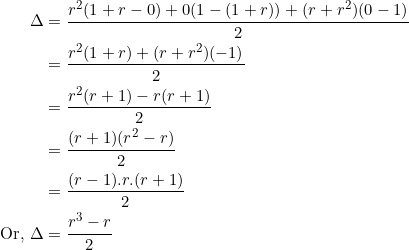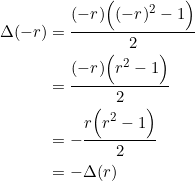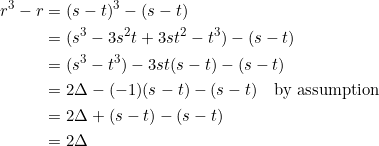We investigated the area property of our very own triangle, and guess what! The depressed cubic showed up.
Ww!!! How???
Consider ![]() with vertices at
with vertices at ![]() , where
, where ![]() . PROVE that its area
. PROVE that its area ![]() can be given by
can be given by ![]() .
.
Easy-peasy.
We were given the coordinates ![]() . We simply use the well-known area formula
. We simply use the well-known area formula
![]()
and, by taking ![]() ,
, ![]() ,
, ![]() , we obtain
, we obtain

Observe that the numerator contains three consecutive factors, namely ![]() , and
, and ![]() . Thus, if
. Thus, if ![]() is an integer, then at least one of the three will be even, and so the resulting product
is an integer, then at least one of the three will be even, and so the resulting product ![]() will be even. This means that the area
will be even. This means that the area ![]() will be an integer — and a multiple of a triangular number.
will be an integer — and a multiple of a triangular number.
The depressed cubic
A cubic equation of the form ![]() in which the second degree term
in which the second degree term ![]() is missing, is usually called a depressed cubic. For a discussion on how to solve such equations, see here.
is missing, is usually called a depressed cubic. For a discussion on how to solve such equations, see here.
Suppose we re-arrange our area formula ![]() as
as
![]()
then we obtain not just a depressed cubic, but a restricted, simplified, specialized, depressed cubic. As such, its solution also takes a relatively simplified form.
PROVE that the area formula obtained previously, namely ![]() , is an odd function.
, is an odd function.
Recall that an odd function ![]() satisfies
satisfies ![]() . Let’s write
. Let’s write ![]() . Then
. Then

One implication of this “oddness” is that two opposite values of ![]() will yield the “same” area. As such, when we solve the depressed cubic equation
will yield the “same” area. As such, when we solve the depressed cubic equation
![]()
for ![]() , we must remember that any solution we obtain has a corresponding opposite, but the associated opposite doesn’t arise as a solution of the depressed cubic. For example, if
, we must remember that any solution we obtain has a corresponding opposite, but the associated opposite doesn’t arise as a solution of the depressed cubic. For example, if ![]() is a solution of the depressed cubic, then we must also consider
is a solution of the depressed cubic, then we must also consider ![]() , despite the fact that
, despite the fact that ![]() is not a solution of the depressed cubic (see the exercises at the end).
is not a solution of the depressed cubic (see the exercises at the end).
For the depressed cubic ![]() , PROVE that
, PROVE that ![]() can be given in terms of
can be given in terms of ![]() by:
by: ![Rendered by QuickLaTeX.com \boxed{r=\sqrt[3]{\frac{9\Delta+\sqrt{81\Delta^2-3}}{9}}-\sqrt[3]{\frac{-9\Delta+\sqrt{81\Delta^2-3}}{9}}}](https://blog.fridaymath.com/wp-content/ql-cache/quicklatex.com-b42dcbe2668fc60dd6b9d714ad947891_l3.png)
Let’s do this!
Following the standard method of solving a depressed cubic, we seek ![]() and
and ![]() such that
such that ![]() and
and ![]() . Then,
. Then, ![]() is a solution of
is a solution of ![]() . Indeed, we have:
. Indeed, we have:

So it remains to find such ![]() and
and ![]() that satisfy
that satisfy ![]() and
and ![]() . Isolate
. Isolate ![]() from the second equation:
from the second equation: ![]() . Substituting, the equation
. Substituting, the equation ![]() becomes:
becomes:
![]()
Clear fractions and bring all terms to the left side:
![]()
Since this is now a quadratic in ![]() , we can use the quadratic formula to isolate
, we can use the quadratic formula to isolate ![]() . Doing this gives:
. Doing this gives:
![]()
Simplifying,
![Rendered by QuickLaTeX.com \[s^3=\frac{9\Delta\pm\sqrt{81\Delta^2-3}}{9},~\textrm{or}~s=\sqrt[3]{\frac{9\Delta\pm\sqrt{81\Delta^2-3}}{9}}.\]](https://blog.fridaymath.com/wp-content/ql-cache/quicklatex.com-634b2bdff88adbfd6d9e2ff97d5fcac5_l3.png)
It suffices to take ![]() . Then,
. Then, ![]() gives
gives ![]() :
:
![Rendered by QuickLaTeX.com \begin{equation*} \begin{split} t^3&=\frac{9\Delta+\sqrt{81\Delta^2-3}}{9}-2\Delta\\ &=\frac{9\Delta+\sqrt{81\Delta^2-3}}{9}-\frac{18\Delta}{9}\\ &=\frac{-9\Delta+\sqrt{81\Delta^2-3}}{9}\\ \implies t&=\sqrt[3]{\frac{-9\Delta+\sqrt{81\Delta^2-3}}{9}} \end{split} \end{equation*}](https://blog.fridaymath.com/wp-content/ql-cache/quicklatex.com-f4f7da93b768a71ccf7dad8f919b053c_l3.png)
Finally,
![Rendered by QuickLaTeX.com \[r=s-t=\sqrt[3]{\frac{9\Delta+\sqrt{81\Delta^2-3}}{9}}-\sqrt[3]{\frac{-9\Delta+\sqrt{81\Delta^2-3}}{9}}.\]](https://blog.fridaymath.com/wp-content/ql-cache/quicklatex.com-926e7b88924bc5b943806b801d794937_l3.png)
Using the preceding example, PROVE that ![]() if, and only if,
if, and only if, ![]() .
.
First suppose that ![]() . Then
. Then ![]() . And so
. And so
![Rendered by QuickLaTeX.com \[r=\sqrt[3]{\frac{9\Delta+\sqrt{81\Delta^2-3}}{9}}-\sqrt[3]{\frac{-9\Delta+\sqrt{81\Delta^2-3}}{9}}\]](https://blog.fridaymath.com/wp-content/ql-cache/quicklatex.com-ee8d129c18c22631fb2697e0e291c54d_l3.png)
reduces to
![Rendered by QuickLaTeX.com \begin{equation*} \begin{split} r&=\sqrt[3]{\Delta}-\sqrt[3]{-\Delta}\\ &=2\sqrt[3]{\Delta}\\ &=2\sqrt[3]{\frac{\sqrt{3}}{9}}\\ &=\frac{2\sqrt{3}}{3} \end{split} \end{equation*}](https://blog.fridaymath.com/wp-content/ql-cache/quicklatex.com-d957d1e25da450f0bf9ed03888f925e3_l3.png)
Conversely, if ![]() , then from the depressed cubic equation
, then from the depressed cubic equation ![]() , we obtain
, we obtain
![Rendered by QuickLaTeX.com \begin{equation*} \begin{split} \Delta&=\frac{r^3-r^}{2}\\ &=\frac{r(r^2-1)}{2}\\ &=\frac{\frac{2\sqrt{3}}{3}\Big[\Big(\frac{2\sqrt{3}}{3}\Big)^2-1\Big]}{2}\\ &=\frac{2\sqrt{3}}{3}\times\frac{1}{3}\times\frac{1}{2}\\ &=\frac{\sqrt{3}}{9} \end{split} \end{equation*}](https://blog.fridaymath.com/wp-content/ql-cache/quicklatex.com-37a706b8be217f179816a45c89c378fd_l3.png)
Discuss the nature of the roots of the depressed cubic ![]() .
.
We use the cubic discriminant to this end. For a general cubic ![]() , its discriminant is given by the quantity
, its discriminant is given by the quantity
![]()
Putting ![]() ,
, ![]() ,
, ![]() , and
, and ![]() , we obtain, for the depressed cubic
, we obtain, for the depressed cubic ![]() :
:
![]()
which reduces to ![]() . Consequently:
. Consequently:
- if
 , then the depressed cubic has three real roots, one of which is repeated;
, then the depressed cubic has three real roots, one of which is repeated; - if
 , then the depressed cubic has three distinct real roots;
, then the depressed cubic has three distinct real roots; - if
 , the depressed cubic has one real root and two complex roots.
, the depressed cubic has one real root and two complex roots.
Solve the depressed cubic equation ![]() .
.
Observe that this is the case in which ![]() . The corresponding cubic discriminant
. The corresponding cubic discriminant ![]() becomes
becomes ![]() . As such, we expect a repeated root. From Example 4, one of the roots is
. As such, we expect a repeated root. From Example 4, one of the roots is ![]() . Accordingly,
. Accordingly, ![]() is a factor of
is a factor of ![]() . By long division, we get the quadratic factor
. By long division, we get the quadratic factor ![]() , which is a perfect square:
, which is a perfect square:
![]()
Thus, the complete solution to ![]() is
is ![]() . Notice how this solution set becomes “increased” in the next example.
. Notice how this solution set becomes “increased” in the next example.
Example
![]() has an area of
has an area of ![]() . The slopes of its sides form a geometric sequence
. The slopes of its sides form a geometric sequence ![]() . Find possible coordinates for the vertices
. Find possible coordinates for the vertices ![]() .
.
Since the slopes of the sides form the geometric sequence ![]() , we can place the vertices at
, we can place the vertices at ![]() ,
, ![]() , and
, and ![]() . The area will then be
. The area will then be ![]() , in view of Example 1. But we’re given that the area is
, in view of Example 1. But we’re given that the area is ![]() :
:
![]()
which is the depressed cubic solved in the preceding example. Recall that the cubic has ![]() as solutions.
as solutions.
Being that the area formula ![]() is an odd function (Example 2), we should also consider
is an odd function (Example 2), we should also consider ![]() as possible values for the common ratio
as possible values for the common ratio ![]() , even though these are not solutions to the depressed cubic.
, even though these are not solutions to the depressed cubic.
- for
 , the coordinates will be
, the coordinates will be  ,
,  ,
,  ;
; - for
 , the coordinates will be
, the coordinates will be  ,
,  ,
,  ;
; - for
 , the coordinates will be
, the coordinates will be  ,
,  ,
,  ;
; - for
 , the coordinates will be
, the coordinates will be  ,
,  ,
,  .
.
Since the area ![]() is so small, each case produces a rare-listic diagram when drawn.
is so small, each case produces a rare-listic diagram when drawn.
Example (“Fixed point”)
Find coordinates for the vertices of a ![]() whose slopes are
whose slopes are ![]() and whose area is
and whose area is ![]() sq. units.
sq. units.
We solve the cubic equation ![]() using
using ![]() :
:
![]()
the quadratic part has complex roots. Again, we should consider ![]() , despite the fact that it’s not a solution to the current cubic equation.
, despite the fact that it’s not a solution to the current cubic equation.
Next, let’s use the coordinates ![]() ,
, ![]() ,
, ![]() :
:
![]()
In this case, the area and the common ratio are the same.
Give an example of a scalene triangle with non-zero side slopes, irrational side lengths, and an integer area.
The only challenge with this question is the non-zero slopes requirement; otherwise we could just have taken a triangle with one side on the ![]() -axis and the rest becomes easy.
-axis and the rest becomes easy.
Luckily, we can always turn to triangles with slopes in geometric progressions. In this case we take ![]() with vertices at
with vertices at ![]() . The side slopes are
. The side slopes are ![]() . For the side lengths we have
. For the side lengths we have ![]() ,
, ![]() , and
, and ![]() , all irrational and all different, so the triangle is scalene. Its area is
, all irrational and all different, so the triangle is scalene. Its area is ![]() sq. units.
sq. units.
Let ![]() be a root of the depressed cubic
be a root of the depressed cubic ![]() . PROVE that
. PROVE that ![]() .
.
Since ![]() (an area), it follows that
(an area), it follows that ![]() as well. This ensures that the quantity
as well. This ensures that the quantity ![]() is defined.
is defined.
Set
![]()
Comparing coefficients of like terms, ![]() , and
, and ![]() . So
. So ![]() ,
, ![]() , and again
, and again ![]() . The two expressions for
. The two expressions for ![]() yield
yield ![]() , which is valid because
, which is valid because ![]() is a root of the original cubic
is a root of the original cubic ![]() .
.
![]()
Takeaway
If ![]() with vertices at
with vertices at ![]() is such that the slopes of sides
is such that the slopes of sides ![]() are
are ![]() , respectively, then the area
, respectively, then the area ![]() of the triangle can be given by
of the triangle can be given by
![]()
By restricting the coordinates in a suitable way (see the exercises below), we obtain the depressed cubic ![]() as the area.
as the area.
Tasks
- (Special square) For any right triangle with vertices
 ,
,  , and
, and  , PROVE that:
, PROVE that: 
(Notice how squaring respects addition in this case. In addition, not all four absolute values on the left are absolutely necessary .)
.) - (Special square) For any triangle with centroid
 , circumcenter
, circumcenter  , and orthocenter
, and orthocenter  , PROVE that:
, PROVE that: 
(Notice the absolute absence of absolute values in this case — so long as and
and  . Also, any right triangle satisfies this property “TWICE” — with its regular vertices, and also with its three principal centers.)
. Also, any right triangle satisfies this property “TWICE” — with its regular vertices, and also with its three principal centers.) - (Opposite roots) PROVE that if a depressed cubic
 has two opposite solutions, namely
has two opposite solutions, namely  and
and  , then
, then  .
.
(In our own case, the right member represents the area
represents the area  of a certain, obscure triangle. Since
of a certain, obscure triangle. Since  , this explains why the depressed cubic equation
, this explains why the depressed cubic equation  cannot have two opposite solutions.)
cannot have two opposite solutions.)  has vertices at
has vertices at  . Assume that the slopes of sides
. Assume that the slopes of sides  are
are  , in that order.
, in that order.
- PROVE that its area
 can be given by
can be given by 
- Find an appropriate choice of
 for which the area
for which the area  reduces to the depressed cubic
reduces to the depressed cubic 
- PROVE that its area
 has vertices at
has vertices at  ,
,  ,
,  . PROVE that:
. PROVE that:
- the coordinates of the foot of the altitude from vertex
 is
is  ;
; - the length of the altitude from vertex
 is
is  ;
; - the area of
 is
is  .
.
- the coordinates of the foot of the altitude from vertex
- Consider
 with vertices at
with vertices at  ,
,  ,
,  . Its side slopes are
. Its side slopes are  , a geometric progression in which
, a geometric progression in which  and
and  .
.
- Use the area formula in exercise 4 above to compute its area;
- Use the area formula in exercise 5 above to compute its area;
- Compute its area in the regular way, using
 ;
; - Explain why the formula in exercise 5 did not work correctly in this case.
- For
 with vertices at
with vertices at  ,
,  ,
,  , PROVE that:
, PROVE that:
- its centroid is located at
 ;
; - its circumcenter is at
 ;
; - its orthocenter is at
 ;
; - the slope of its Euler line is
 .
.
- its centroid is located at
- (Same ratio) Given
 ,
,  ,
,  , PROVE that the centroid, the circumcenter, and the orthocenter of
, PROVE that the centroid, the circumcenter, and the orthocenter of  lie on parallel lines
lie on parallel lines  ,
,  , and
, and  , respectively.
, respectively.
(Notice that the line through the centroid is in the middle of the other two lines. Moreover, these lines preserve the usual ratio in which the centroid divides the circumcenter-orthocenter distance.)
ratio in which the centroid divides the circumcenter-orthocenter distance.) - If
![Rendered by QuickLaTeX.com \sqrt[3]{a+\sqrt{b}}=c+\sqrt{d}](//blog.fridaymath.com/wp-content/plugins/a3-lazy-load/assets/images/lazy_placeholder.gif) , PROVE that
, PROVE that ![Rendered by QuickLaTeX.com \sqrt[3]{-a+\sqrt{b}}=-c+\sqrt{d}](//blog.fridaymath.com/wp-content/plugins/a3-lazy-load/assets/images/lazy_placeholder.gif) .
. - (Unit area) Find coordinates for the vertices of
 with slopes
with slopes  and an area of
and an area of  sq. unit.
sq. unit.